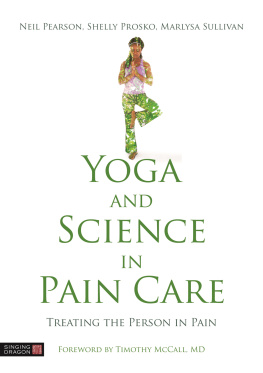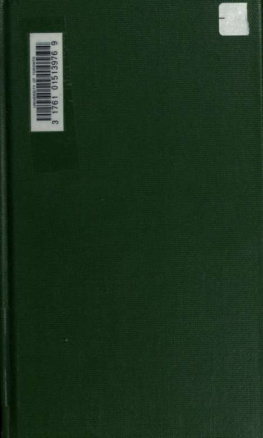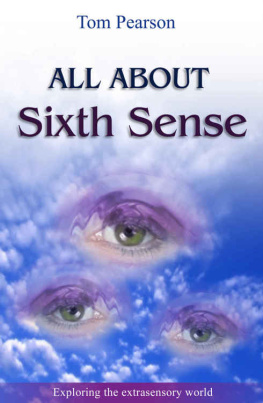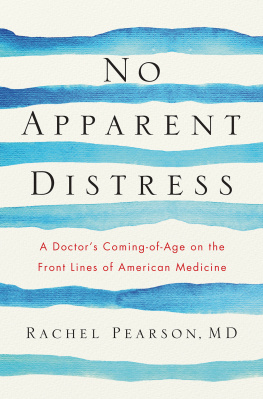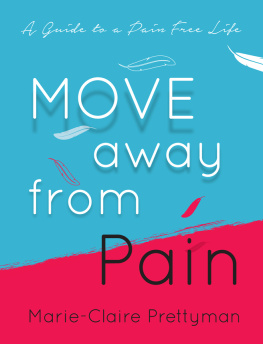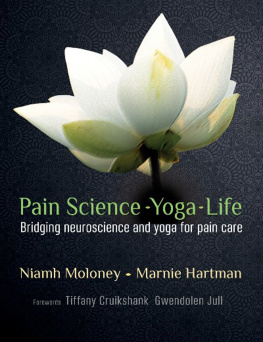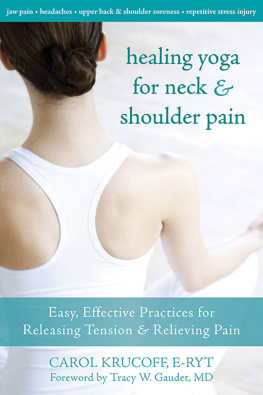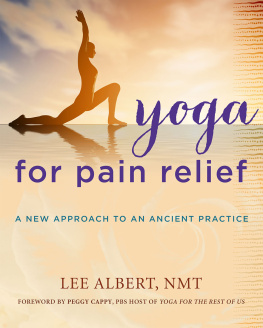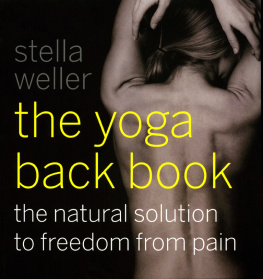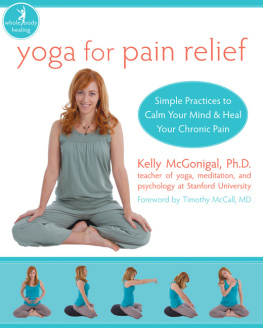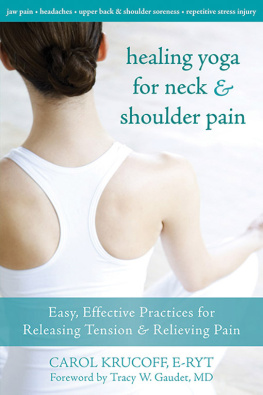
YOGA and SCIENCE
in PAIN CARE
TREATING THE PERSON IN PAIN
E DITED BY NEIL PEARSON, SHELLY
PROSKO AND MARLYSA SULLIVAN
Foreword by Timothy McCall

Contents
Foreword
Several years ago, I received an email with tragic news. My college friend Todd, brilliant, talented and one of the funniest people Ive ever known, had committed suicide. Hed suffered from an extremely painful neurologic condition and apparently couldnt take it anymore. Wed lost touch years earlier, and I imagined that he had exhausted every treatment option offered to him without finding relief. I felt especially sad because I suspected that some of the tools Id learned in yoga and yoga therapythat he likely hadnt been exposed tomight well have made a difference. That emotion was only heightened when I discovered that Todd, who Id met in Madison, Wisconsin, and I had been living in the same Northern California town.
More recently, in my own journey through metastatic head and neck cancer, I had a few months of severe pain due to tissue damage caused by chemoradiation. My radiation oncologist had prescribed opioids during my second week of treatmenta good choice I felt given the acute nature of my discomfort and my low risk of becoming addicted. Likely due to all the yogic, Ayurvedic and the other holistic healing approaches I was using, however, I didnt end up needing to take those narcotics until more than a month later, and easily weaned myself off as the pain diminished. In the meantime, the drugs had made a big difference in keeping me more comfortable.
Unfortunately, opioids are turning out to be more problematic for chronic pain. One reason is that when pain-relieving drugs are taken long term, they tend to lose effectiveness, a phenomenon known medically as tachyphylaxis. To get the same analgesic effect you need to steadily increase the dosesimultaneously increasing the side effects and the addiction potential. The unskillful use of narcotic pain relievers in chronic pain is widely considered a major contributor to the current opioid crisis.
What is needed urgently are non-drug measures for chronic pain, and yoga and its varied toolboxincluding meditation, mindful awareness, mindful movement and breathing techniques aimed at lessening the reactivity of the nervous system as well as the mindoffer great promise. Better still, not only are yogic approaches not subject to tachyphylaxis, the opposite seems to be true. The longer and more steadily yoga tools are employed the more powerful they become. Slowly, like interest building in a compound savings account, the benefits accrue. The practice of yoga even offers the possibility of entirely transforming the patients relationship to their pain, even in cases where it cannot be entirely relievedsomething that no drug can do.
As this book skillfully documents, there is promising, though incomplete, scientific support, for the use of yogic approaches in chronic pain. Some cautious observers say more data are needed before we can recommend yoga to patients in pain. While no one disputes the desirability of further scientific investigation, given all that is at stake, such reticence may cause unfortunate side effects, both for society in general and for countless individuals, desperate like my late friend Todd, for whom yoga might offer some measure of relief.
Good doctors weigh the risks versus the benefits of any medical intervention. When this logic is applied to yoga for people with chronic pain, the equation is lopsided. Unlike drugs which kill tens of thousands of patients every yeareven when used as prescribedas far as we know there has never been a single death attributable to yoga therapy. Yoga, particularly the vigorous yoga taught in some classes, can cause injuries, but they appear to be rare in yoga therapy, which by definition is tailored to each clients unique constellation of aptitudes and limitations. Compared to conventional medical approaches, the cost of yoga therapy is low. Most people who try it seem to like it.
Finally, consider this: almost all studies of yoga are of short duration due to the chronic shortage of funding for such research. Studies lasting a few weeks or months will tend to underestimate the benefits of a practice, which builds in effectiveness slowly over time. Further, due to the requirements of evidence-based medicine, yoga studies are almost always of standardized treatment protocols, in which every person is prescribed the same exact same poses, breathing techniques, etc. These protocols lack the personalization that skilled yoga therapists insist boosts both the effectiveness and safety of the practices prescribed. Of course, this notion needs to be studied, but to the extent that its true, the research to date will have once again systematically underestimated yoga therapys true potential.
Modern medicine has spent billions of dollars in its efforts to understand and relieve chronic pain, with some notable successes, yet it lacks satisfactory solutions for many patients. What medicine has focused on much less, however, is the relief of suffering. Suffering can fuel the fire of chronic pain. Understanding the causes of suffering and how it can be lessened has been a central focus of yoga for thousands of years. The time is right to apply this wisdom to the millions of chronic pain sufferers whose need for it is pressing. Yoga and Science in Pain Care , scientifically savvy, informed by clinical experience and rich in yogic insight, shows us the way.
Timothy McCall, MD
Preface
N EIL P EARSON , S HELLY P ROSKO , M A RLYSA S ULLIVAN
The three of us share a passion for helping people in pain. Combined, we have decades of experience in both working with clients in pain and providing education to healthcare professionals on how to help people in pain through yoga. Separately, we had each thought about and been approached to write on this topic. As we thought about what a book would look like on this topic of yoga, science and pain care, it was apparent that this project would be best served through collaboration. A book about pain should mirror the complexity and multifaceted nature of the subject.
Just as pain can only be understood from holistic and integrated perspectives, our intention was to create a book that could reflect the multifaceted nature of pain and the human experience. With the complexity of the topic, and to ensure we offered a variety of perspectives to prevent our own biases from dominating the project, we decided to invite esteemed colleagues to share their knowledge, experience and wisdom. As a group effort, we felt this book could provide a more expansive and in-depth understanding while capturing the essence of important aspects of pain and pain care.
We each contemplated our own gifts, focus and perspectives on pain care as well as that of inspiring colleagues. This book is an attempt to demonstrate this collective dialogue through exploring various perspectives on pain care. We sought to include essential and relevant topics that would cover an understanding of pain itself, the lived experience of pain and fundamental topics for pain management and pain care.
We hope this book meets your needs. A growing number of people are seeking yoga when they have pain and a growing number of rehabilitation professionals are integrating yoga into their work. As well, health professionals are seeking support and guidance on how to incorporate a biopsychosocial-spiritual (BPSS) approach into their treatments. This book will help alleviate the system-wide lack of available resources, specifically on a BPSS approach to helping individuals with persistent pain.
Next page
